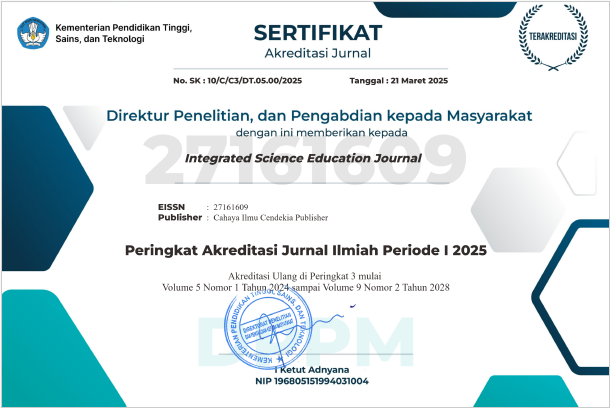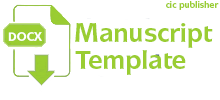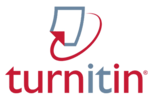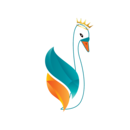Analysis Analysis of Ethno-STEM-Integrated PBL E-Module to Enhance Creative Thinking Skills of 8th Grade Junior High School Students
Abstract
Purpose of the study: This research aims to analyze the needs for developing an Ethno-STEM-integrated Problem-Based Learning (PBL) e-module to enhance the creative thinking skills of 8th-grade junior high school students on the topics of vibrations, waves, and sound.
Methodology: This study employed a mixed method. The instrument used was a questionnaire adapted from previous research. The sample consisted of junior high school science teachers and students in Karanganyar Regency. Data analysis used descriptive statistics.
Main Findings: The findings revealed a significant gap between current science learning practices and the demands of 21st-century education. Teachers reported difficulties in explaining abstract concepts such as vibrations, waves, and sound using conventional methods, compounded by the limited availability of instructional media that integrates local cultural wisdom. Meanwhile, students expressed strong interest in digital and contextual learning resources, yet their creative thinking skills remained low, with an average score of only 49.4%. This indicates the urgent need for innovative, interactive, and culturally relevant learning solutions.
Novelty/Originality of this Study: The development of an Ethno-STEM-based PBL e-module that not only integrates science, technology, engineering, and mathematics with local wisdom but also explicitly targets the four core aspects of creative thinking: fluency, flexibility, originality, and elaboration. Unlike conventional modules, this approach leverages ethnoscience contexts to make abstract concepts more tangible while simultaneously fostering problem-solving and higher-order thinking. Thus, the research provides a strategic foundation for designing learning media that is pedagogically sound, culturally meaningful, and aligned with the competencies required in the global era.
References
D. Yanti, S. Prastawa, W. F. Utomo, V. Wiliyanti, and B. Utomo, “Pendidikan di revolusi industri 4.0: Studi kasus evaluasi kurikulum merdeka di Indonesia [Education in the Industrial Revolution 4.0: A case study of the evaluation of the independent curriculum in Indonesia],” Edu Cendikia: Jurnal Ilmiah Kependidikan, vol. 4, no. 02, pp. 380–390, Aug. 2024, doi: 10.47709/educendikia.v4i02.4471.
S. H. Iman, M. Yusuf, T. Abdjul, and A. H. Odja, “Pengembangan E-Modul kearifan lokal berbantuan aplikasi flipping book pada materi getaran, gelombang dan bunyi di SMP Negeri 3 Kabila [Development of local wisdom e-modules assisted by flipping book applications on vibration, wave and sound material at SMP Negeri 3 Kabila],” ORBITA: Jurnal Pendidikan dan Ilmu Fisika, vol. 9, no. 2, pp. 294-304, 2023, doi: 10.31764/orbita.v9i2.16812
W. Sumarni and S. Kadarwati, “Ethno-STEM project-based learning: Its impact to critical and creative thinking skills,” Jurnal Pendidikan IPA Indonesia, vol. 9, no. 1, pp. 11–21, 2020, doi: 10.15294/jpii.v9i1.21754.
S. M. Akramul Kabir, “Thematic analysis: A practical guide,” Pasaa Paritat Journal, vol. 39, pp. 142–145, 2024, doi: 10.58837/chula.ppj.39.8.
B. Dianita, “Problem based learning model with experiential learning to increase creative thinking and critical thinking ability,” Jurnal Penelitian dan Pengembangan Pendidikan, vol. 7, no. 2, pp. 328–335, Jun. 2023, doi: 10.23887/jppp.v7i2.62254.
P. I. M. Waruwu and Y. Helsa, “Implementasi pembelajaran aktif untuk meningkatkan keterlibatan siswa di sekolah dasar [Implementation of active learning to increase student engagement in elementary schools],” Jurnal Arjuna : Publikasi Ilmu Pendidikan, Bahasa dan Matematika, vol. 3, no. 3, pp. 255–267, May 2025, doi: 10.61132/arjuna.v3i3.1942.
K. Børte, K. Nesje, and S. Lillejord, “Barriers to student active learning in higher education,” Teaching in higher education, vol. 28, no. 3, pp. 597-615, 2023, doi: 10.1080/13562517.2020.1839746
M. Y. Ahmad and I. Mawarni, “Kreativitas belajar peserta didik pada pembelajaran pendidikan agama islam: pengaruh lingkungan sekolah dalam pengajaran [Student learning creativity in Islamic religious education: the influence of the school environment on teaching],” Jurnal Pendidikan Agama Islam Al-Thariqah, vol. 6, no. 2, pp. 222–243, Dec. 2021, doi: 10.25299/al-thariqah.2021.vol6(2).7382.
A. Raup, W. Ridwan, Y. Khoeriyah, S. Supiana, and Q. Y. Zaqiah, “Deep learning dan penerapannya dalam pembelajaran [Deep learning and its application in learning],” JIIP-Jurnal Ilmiah Ilmu Pendidikan, vol. 5, no. 9, pp. 3258-3267, 2022, doi: 10.54371/jiip.v5i9.805.
A. J. Khoiriyah and H. Husamah, “Problem-based learning: Creative thinking skills, problem-solving skills, and learning outcome of seventh grade students,” JPBI (Jurnal Pendidikan Biologi Indonesia), vol. 4, no. 2, pp. 151–160, Jul. 2018, doi: 10.22219/jpbi.v4i2.5804.
R. Inayahm, P. Aswirna, and A. Asrar “Pengembangan e-modul berbasis etno-STEM berbantuan canva terintegrasi gordang sambilan terhadap keterampilan komunikasi peserta didik [Development of ethno-STEM based e-modules assisted by Canva integrated with Gordang Sambilan on students' communication skills],” Jurnal Cerdas Mahasiswa, vol 4, no. 2, 2022, doi: 10.15548/jcm.v4i2.4784.
F. S. A. Nugraheni, “Analysis of instrument validity and needs for Ethno-STEM based science e-modules to strengthen pancasila student profiles,” Jurnal Penelitian Pendidikan IPA, vol. 11, no. 2, pp. 381-387, 2025, doi: 10.29303/jppipa.v11i2.9731.
L. Judijanto, “Analisis pengaruh tingkat literasi digital guru dan siswa terhadap kualitas pembelajaran di era digital di Indonesia [Analysis of the influence of digital literacy levels of teachers and students on the quality of learning in the digital era in Indonesia],” Sanskara Pendidikan Dan Pengajaran, vol. 2, no. 2, pp. 50–60, 2024, doi: 10.58812/spp.v2i02.391.
S. Xu, M. J. Reiss, and W. Lodge, “Comprehensive scientific creativity assessment (C-SCA): A new approach for measuring scientific creativity in secondary school students,” Int J Sci Math Educ, vol. 23, no. 2, pp. 293–319, Feb. 2025, doi: 10.1007/s10763-024-10469-z.
M. Binkley et al., “Defining twenty-first century skills,” in Assessment and teaching of 21st century skills, Springer Netherlands, 2014, pp. 17–66. doi: 10.1007/978-94-007-2324-5_2.
I. Ombili, and T. Buhungo, “Pengembangan E-Modul interaktif materi gelombang bunyi di SMA Negeri 6 Gorontalo Utara: Efektivitas, Kepraktisan, dan Validitas [Development of an interactive e-module on sound wave material at SMA Negeri 6 North Gorontalo: Effectiveness, Practicality, and Validity].” Khazanah Akademia, vol. 8, no. 2, pp. 112-122, 2024, doi: 10.52434/jurnalkhazanahakademia.v8i02.402.
M. P. Fahrurrozi, M. P. Edwita, and M. P. T. Bintoro, Model-Model Pembelajaran Kreatif Dan Berpikir Kritis Di Sekolah Dasar [Creative Learning And Critical Thinking Models In Elementary Schools]. Unj Press, 2022.
J. Khatib Sulaiman Dalam No, E. Sabrina, and H. Maksum, “A Meta-Analysis of the Problem-Based learning model to enhance students’ creative thinking skills,” Indonesian Journal of Computer Science Attribution, vol. 13, no. 2, pp. 2024–1874.
S. Lavado-Anguera, P. J. Velasco-Quintana, and M. J. Terrón-López, “Project-based learning (PBL) as an experiential pedagogical methodology in engineering education: A review of the literature,” Education Sciences, vol. 14, no. 6, pp. 617, 2024, doi: 10.3390/educsci14060617.
W. Sumarni, “Pjbl-Etno-STEM: Potensi dan kontribusinya dalam peningkatan keterampilan abad 21 dan karakter konservasi mahasiswa,” Bookchapter Pendidikan Universitas Negeri Semarang, vol. 6, pp. 49-80, 2023.
E. Maryanti, T. Suminar, and . E., “Development of Ethno-STEM E-Module with project based learning model based on Yogyakarta local wisdom to improve student’s creative thinking abilities,” International Journal of Research and Review, vol. 10, no. 10, pp. 105–114, Oct. 2023, doi: 10.52403/ijrr.20231014.
K. Aditia, S. Sarwanto, and M. Masykuri, “Analysis of validity and practicality of Ethno-STEM based science E-Modules to enhance critical thinking skills and independence of students,” Journal of Natural Science and Integration, vol. 7, no. 2, p. 264, Oct. 2024, doi: 10.24014/jnsi.v7i2.32828.
S. Karim, N. Y. Kandowangko, and C. Lamangantjo, “Efektivitas perangkat pembelajaran berbasis Etno-STEM untuk meningkatkan keterampilan berpikir kreatif peserta didik [The effectiveness of Ethno-STEM based learning tools to improve students' creative thinking skills],”. Bioedukasi: Jurnal Pendidikan Biologi, vol. 13, no. 2, pp. 134-142, 2022, doi: 10.24127/bioedukasi.v13i2.6329.
W. P. A. Rayis, L. Herayanti, S. Prayogi, and N. Kurnia, “Integration of ethnoscience in science learning: An ethnoscience study on the palm sugar production process,” Lensa: Jurnal Kependidikan Fisika, vol. 11, no. 2, p. 97, Dec. 2023, doi: 10.33394/j-lkf.v11i2.14455.
H. A. Agusti, Asrizal, R. Amnah, Hidayati, and Helma, “Development of Ethno-STEM integrated digital teaching material of heat concept to promote students’ learning and innovation skills,” Jurnal Penelitian Pendidikan IPA, vol. 10, no. 11, pp. 8290–8299, Nov. 2024, doi: 10.29303/jppipa.v10i11.9054.
R. N. Antika, and S. Nawawi, “Pengaruh model project based learning pada mata kuliah seminar terhadap keterampilan berpikir kreatif mahasiswa [The influence of the project-based learning model in seminar courses on students' creative thinking skills],” Jurnal Pendidikan Biologi Indonesia, vol. 3, no. 1, pp. 72-79, 2017, doi: 10.22219/jpbi.v3i1.3905.
L. U. Ali and M. Zaini, “Development of Interactive e-modules based on local wisdom using android to improve students’ higher order thinking skills (HOTS),” Jurnal Penelitian Pendidikan IPA, vol. 9, no. 11, pp. 10091–10100, Nov. 2023, doi: 10.29303/jppipa.v9i11.4515.
F. Lafifa, D. Rosana, S. Suyanta, S. Nurohman, and S. R. Dwi Astuti, “Integrated STEM approach to improve 21st century skills in Indonesia: A systematic review,” International Journal of STEM Education for Sustainability, vol. 3, no. 2, pp. 252–267, Jul. 2023, doi: 10.53889/ijses.v3i2.219.
M. D. W. Ernawati, Yusnidar, Harianto, S. M. Husna, and Minarsih, “Creative thinking skills on the response to problem-based learning in biochemistry courses,” Mimbar Ilmu, vol. 28, no. 2, pp. 291–299, Aug. 2023, doi: 10.23887/mi.v28i2.59604.
A. Nurdiana and C. Caswita, “Analisis kemampuan berpikir kreatif siswa dalam menyelesaikan masalah matematika pada materi trigonometri berdasarkan prestasi siswa [Analysis of students' creative thinking abilities in solving mathematical problems in trigonometry material based on student achievement],” Jurnal Cendekia : Jurnal Pendidikan Matematika, vol. 8, no. 1, pp. 315–325, Mar. 2024, doi: 10.31004/cendekia.v8i1.2548.
B. Dianita, “Problem based learning model with experiential learning to increase creative thinking and critical thinking ability,” Jurnal Penelitian dan Pengembangan Pendidikan, vol. 7, no. 2, pp. 328–335, Jun. 2023, doi: 10.23887/jppp.v7i2.62254.
M. Waruwu, “Metode penelitian dan pengembangan (R&D): Konsep, Jenis, Tahapan dan Kelebihan [Research and Development (R&D) Methods: Concepts, Types, Stages and Advantages],” Jurnal Ilmiah Profesi Pendidikan, vol. 9, no. 2, pp. 1220–1230, May 2024, doi: 10.29303/jipp.v9i2.2141.
P. M. Papilaya and P. M. J. Tuapattinaya, “Problem-Based learning dan creative thinking skills students based on local wisdom in Maluku,” AL-ISHLAH: Jurnal Pendidikan, vol. 14, no. 1, pp. 429–444, Apr. 2022, doi: 10.35445/alishlah.v14i1.1406.
A. Ball, H. D. Joyce, and D. Anderson-Butcher, “Exploring 21st century skills and learning environments for middle school youth,” International Journal of School Social Work, vol. 1, no. 1, Sep. 2016, doi: 10.4148/2161-4148.1012.
Thiagarajan, S. (1974). Instructional development for training teachers of exceptional children: A sourcebook.
Y. Pratiwi, M. Qonita, and R. Lestari, “Pengembangan keterampilan berpikir kreatif peserta didik melalui model PBL-ESD [Developing students' creative thinking skills through the PBL-ESD model],” In Proceeding Seminar Nasional IPA (pp. 154-162), 2024.
G. Konstantinos, “Thematic analysis: A practical guide,” Eur J Psychother Couns, vol. 26, no. 3–4, pp. 461–464, Oct. 2024, doi: 10.1080/13642537.2024.2391666.
O. F. Marzuki et al., “Innovating education: A comprehensive review of STEM education approaches,” International Journal of Academic Research in Progressive Education and Development, vol. 13, no. 1, Jan. 2024, doi: 10.6007/ijarped/v13-i1/20490.
R. Silaban, and S. R. Sitinjak, “The effect of using student worksheets with a STEM approach on vibrations, waves, and sound material on learning outcomes of class viii students,” J-CEKI: Jurnal Cendekia Ilmiah, vol. 4, no. 1, pp. 2372-2376, 2024, doi: 10.56799/jceki.v4i1.5940.
A. Rahman et al., “Effectiveness of problem-based learning model in science learning: A Meta-Analysis study,” JUARA : Jurnal Olahraga, vol. 8, no. 2, pp. 713–726, Jul. 2023, doi: 10.33222/juara.v8i2.3128.
Apriliana, F. A., Qomaria, N., Tamam, B., Hadi, W. P., & Yasir, M. (2023). Upaya peningkatan keterampilan berpikir kreatif siswa pada materi pencemaran lingkungan dengan model pembelajaran local wisdom integrated science (Lwis) Terintegrasi STEM [Efforts to improve students' creative thinking skills on environmental pollution material using the Local Wisdom Integrated Science (LWIS) Integrated Stem learning model],” EDUPROXIMA (JURNAL ILMIAH PENDIDIKAN IPA), vol. 5, no. 1, pp. 1-10, 2023, doi: 10.29100/eduproxima.v5i1.3336.
Siripipattanakul, S., Sriboonruang, P., Kaewpuang, P., Limna, P., Jaipong, P., & Sitthipon, T. (2023). Problem-based learning in the digital era. Multidisciplinary Approaches to Research, 1, 209-217, 2023.
L. Yu and Z. M. Zin, “The critical thinking-oriented adaptations of problem-based learning models: a systematic review,” Frontiers Media S.A. 2023, doi: 10.3389/feduc.2023.1139987.
M. Leasa, S. Seriholo, P. M. Papilaya, and J. R. Batlolona, “Research-based learning: creative thinking skills of primary school pupils in science learning,” Journal of Turkish Science Education, vol. 22, no. 2, pp. 318–337, Jun. 2025, doi: 10.36681/tused.2025.016.
A. A. Risnawati, “Pembelajaran Ethno-STEM berbantu google classroom untuk meningkatkan kemampuan berfikir kreatif siswa [Ethno-STEM learning assisted by Google Classroom to improve students' creative thinking skills],” In Prosiding Seminar Nasional Pascasarjana, vol. 3, no. 1, pp. 1051-1056, 2020.
H. Herdiawan, I. Langitasari, and S. Solfarina, “Penerapan PBL untuk meningkatkan keterampilan berpikir kreatif siswa pada konsep koloid [Implementation of PBL to improve students' creative thinking skills on the concept of colloids],” EduChemia (Jurnal Kimia dan Pendidikan), vol. 4, no. 1, p. 24, Jan. 2019, doi: 10.30870/educhemia.v4i1.4867.
L. Yu and Z. M. Zin, “The critical thinking-oriented adaptations of problem-based learning models: A systematic review,” 2023, Frontiers Media S.A. doi: 10.3389/feduc.2023.1139987.
W. O. Pratiwi, P. Pramudiyanti, and R. Perdana, “STEM-Based science E-Module: Is it effective to improve students’ creative thinking skills?,” Jurnal Ilmiah Pendidikan Fisika, vol. 8, no. 1, p. 79, Mar. 2024, doi: 10.20527/jipf.v8i1.9042.
H. Bai, H. Mulder, M. Moerbeek, P. P. M. Leseman, and E. H. Kroesbergen, “The development of divergent thinking in 4- to 6-Year-Old children,” Creat Res J, vol. 36, no. 4, pp. 656–674, 2024, doi: 10.1080/10400419.2023.2182492.
Copyright (c) 2025 Hening Tyas Almira, Sri Yamtinah, Mohammad Masykuri

This work is licensed under a Creative Commons Attribution 4.0 International License.
Authors who publish with this journal agree to the following terms:
- Authors retain copyright and acknowledge that the Integrated Science Education Journal is the first publisher licensed under a Creative Commons Attribution 4.0 International License.
- Authors are able to enter into separate, additional contractual arrangements for the non-exclusive distribution of the journal's published version of the work (e.g., post it to an institutional repository or publish it in a book), with an acknowledgment of its initial publication in this journal.
- Authors are permitted and encouraged to post their work online (e.g., in institutional repositories or on their website) prior to and during the submission process, as it can lead to productive exchanges and earlier and greater citation of published work.







.png)
.png)






